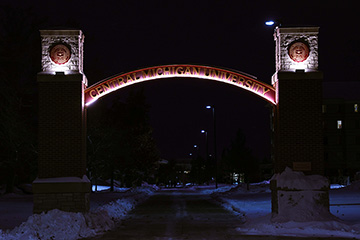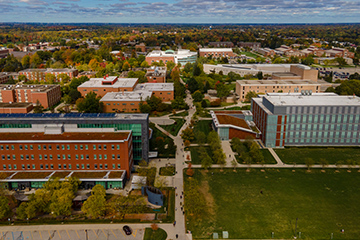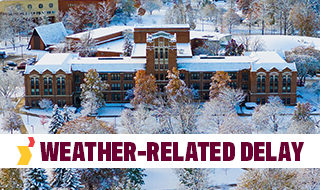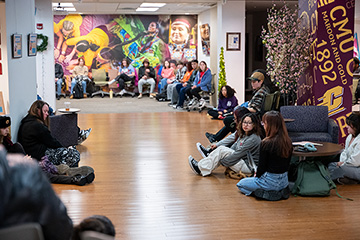What is the impact of increased outdoor recreation?
Parks professor answers question: More people, bigger impact?
Highlights:
- More people using parks leads to an increase in erosion and dangerous wildlife encounters.
- The National Park Service had a maintenance backlog of $22.9 billion in 2024.
- Park managers are using more timed permits to help alleviate the pressure of increased use.
A record number of Americans are heading outdoors for recreation. The trend started during the COVID-19 pandemic and has shown little sign of slacking off. That’s good news for a growing industry. What kind of impact are all of those people having on the most popular destinations?
Robert Dvorak, a professor in CMU’s Department of Recreation, Parks, and Leisure Services Administration, shared his expertise on the impact increased outdoor recreation has on our most-visited parks.
Q. Is the increased interest causing visits to go up equally, or is the increase especially large in some places?
Increased visitation is certainly not equal across all our public lands. A visit to Michigan’s remote Isle Royale National Park still requires a ferry ride, backcountry expertise and planning for the wilderness conditions. But it is the “urban-proximate” parks and forests, those places closest to urban population centers that are experiencing some the largest use increases. As population demographics shift from more rural settings to urban living, residences of Seattle, Denver, Salt Lake City and other places are taking the opportunity to visit nature in growing numbers.
Q. Is the increase in outdoor recreation causing impacts in public recreation locations?
Increased outdoor recreation use can create a variety of impacts, both environmental and social. High use levels can lead to increased erosion, litter, and damage to trails, campsites and facilities. In places like Yellowstone National Park, high-use levels can lead to more dangerous and frequent wildlife encounters, as bison, bears and elk can be in close proximity to people. Higher use levels can also negatively impact water quality due to the improper disposal of human waste. In the case of the Alpine Lakes Wilderness in Washington, increased day use has overwhelmed backcountry toilets in the alpine setting. Surface human waste can affect water sources, wildlife and provide an overall negative experience for visitors.
The impact to the social experience is also directly influenced by increase visitor use. This can mean crowded beaches, crowded trails, and waiting lines for popular destinations. But it can also influence how visitors plan and prepare for their visit. Increase use has necessitated more reservations systems, meaning visitors now must plan more for their vacation. Reservations fill up in early January/February with less flexibility and spontaneity possible. Day use sites now see parking lots filling during early morning hours and “first come, first serve” options for campsites and activities becoming more challenging.
Q. Is the increase in outdoor recreation straining park management resources?
Park management agencies continue to feel the strain of increased use levels as they are asked to accommodate and manage use levels with increasingly insufficient budgets. Use levels impact facilities, roads, visitor centers, campgrounds and other parts of our public lands system. Additionally, underfunding of the park management agencies has led to a growing amount of backlog and deferred maintenance. At the end of 2024, the National Park Service estimated a $22.9 billion backlog of deferred maintenance across the system. This backlog limits park management agencies from responding to changing trends and patterns.
Park agencies also are struggling to maintain necessary staffing. Less staff means fewer individuals in the field for enforcement and education. Recreation research suggests that education through programs and visitor contacts can reduce environmental and social impacts related to inappropriate visitor behaviors. But without necessary staffing levels and resources, park management can struggle to interact with the public, some of whom may have less experience and lack understanding in natural settings.
Q. What solutions have park managers explored and does anything appear to be working?
Park managers have begun implementing several direct and indirect strategies to address increasing use. Some communication strategies have included directing visitors to those days of the week or season of the year when use levels are lower. They also are suggesting other destinations in the area or other parts of the parks that tend to be overlooked.
When these techniques are not sufficient, park managers are trying other techniques to address crowding, congestion and resource impacts. Several national parks, such as Rocky Mountain National Park have created a “timed entry permit” system, where visitors must obtain a permit with a specific time and date for entry. Other places have created timed permits or ticketing for popular hikes and destinations, such as the Angel Landing's Hike in Zion National Park or Half Dome in Yosemite National Park. And others have looked to managing day and overnight use levels to reduce crowding, prevent impacts and provide for visitor safety.
Early evaluation of these solutions has provided some positive results. Visitors are expressing support for the process and justification of its need. But more research related to recreation impacts and visitor use management will be necessary to determine the long-term effects and outcomes of these management strategies.
About Robert Dvorak

Robert Dvorak is a professor in the Department of Recreation, Parks, and Leisure Services Administration. He received both his masters in Recreation Management and his doctorate in Forestry from the University of Montana.
Dvorak’s research interests include wilderness and natural resource management, the human dimensions of wildlife, and park visitor use and behavior.




